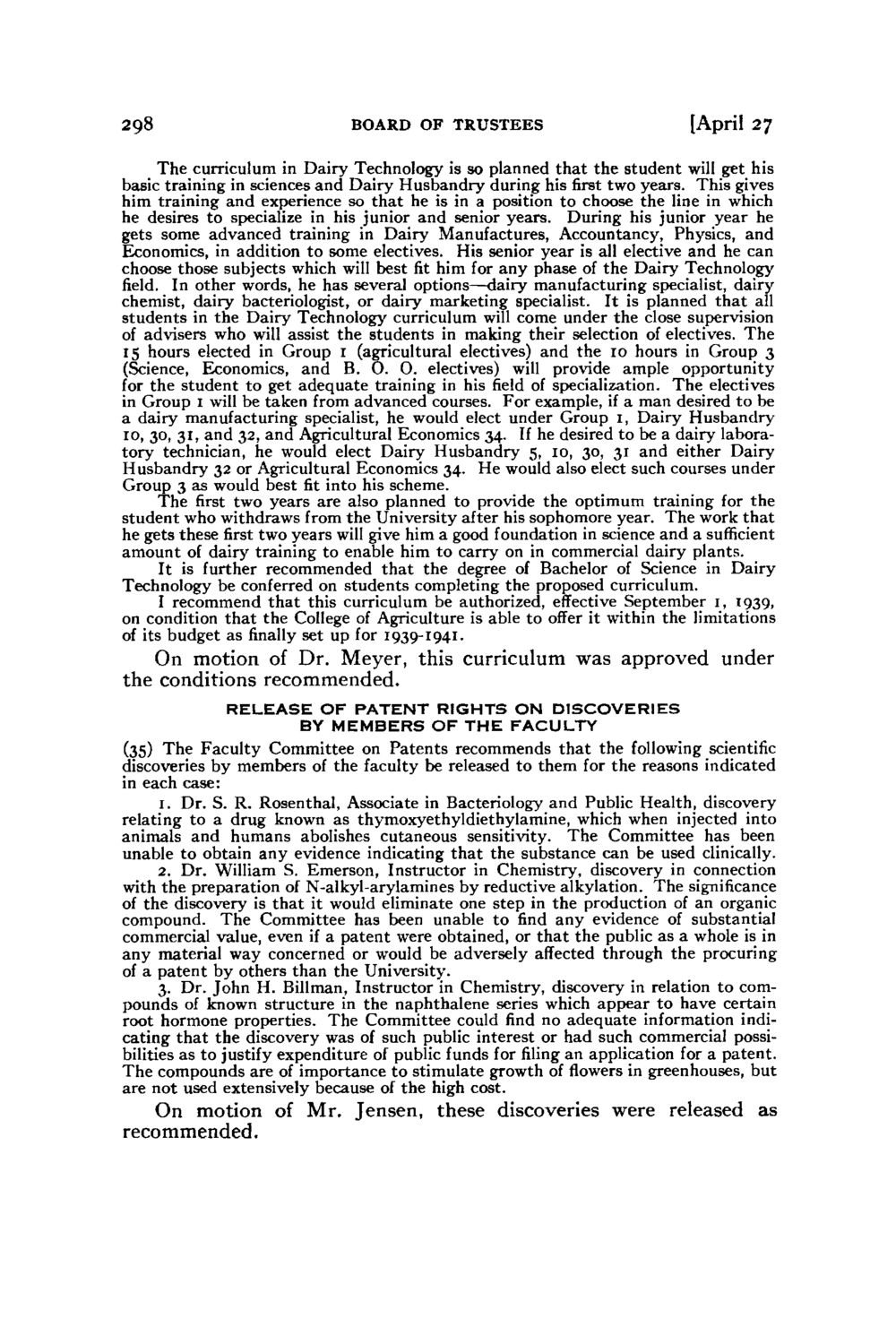| |
| |
Caption: Board of Trustees Minutes - 1940
This is a reduced-resolution page image for fast online browsing.

EXTRACTED TEXT FROM PAGE:
298 BOARD OF TRUSTEES [April 27 The curriculum in Dairy Technology is so planned that the student will get his basic training in sciences and Dairy Husbandry during his first two years. This gives him training and experience so that he is in a position to choose the line in which he desires to specialize in his junior and senior years. During his junior year he gets some advanced training in Dairy Manufactures, Accountancy, Physics, and Economics, in addition to some electives. His senior year is all elective and he can choose those subjects which will best fit him for any phase of the Dairy Technology field. In other words, he has several options—dairy manufacturing specialist, dairy chemist, dairy bacteriologist, or dairy marketing specialist. It is planned t h a t all students in the Dairy Technology curriculum will come under the close supervision of advisers who will assist the students in making their selection of electives. The 15 hours elected in Group 1 (agricultural electives) and the 10 hours in Group 3 (Science, Economics, and B. O. O. electives) will provide ample opportunity for the student to get adequate training in his field of specialization. The electives in Group 1 will be taken from advanced courses. For example, if a man desired to be a dairy manufacturing specialist, he would elect under Group 1, Dairy Husbandry 10, 30, 31, and 32, and Agricultural Economics 34. If he desired to be a dairy laboratory technician, he would elect Dairy Husbandry 5, 10, 30, 31 and either Dairy Husbandry 32 or Agricultural Economics 34. He would also elect such courses under Group 3 as would best fit into his scheme. The first two years are also planned to provide the optimum training for the student who withdraws from the University after his sophomore year. The work that he gets these first two years will give him a good foundation in science and a sufficient amount of dairy training to enable him to carry on in commercial dairy plants. It is further recommended t h a t the degree of Bachelor of Science in Dairy Technology be conferred on students completing the proposed curriculum. I recommend t h a t this curriculum be authorized, effective September 1, 1939, on condition that the College of Agriculture is able to offer it within the limitations of its budget as finally set up for 1939-1941. On motion of Dr. Meyer, this curriculum was approved under the conditions recommended. RELEASE OF PATENT RIGHTS ON DISCOVERIES BY MEMBERS OF THE FACULTY (35) The Faculty Committee on Patents recommends t h a t the following scientific discoveries by members of the faculty be released to them for the reasons indicated in each case: 1. Dr. S. R. Rosenthal, Associate in Bacteriology and Public Health, discovery relating to a drug known as thymoxyethyldiethylamine, which when injected into animals and humans abolishes cutaneous sensitivity. The Committee has been unable to obtain any evidence indicating t h a t the substance can be used clinically. 2. Dr. William S. Emerson, Instructor in Chemistry, discovery in connection with the preparation of N-alkyl-arylamines by reductive alkylation. The significance of the discovery is that it would eliminate one step in the production of an organic compound. The Committee has been unable to find any evidence of substantial commercial value, even if a patent were obtained, or t h a t the public as a whole is in any material way concerned or would be adversely affected through the procuring of a patent by others than the University. 3. Dr. John H. Billman, Instructor in Chemistry, discovery in relation to compounds of known structure in the naphthalene series which appear to have certain root hormone properties. The Committee could find no adequate information indicating that the discovery was of such public interest or had such commercial possibilities as to justify expenditure of public funds for filing an application for a patent. The compounds are of importance to stimulate growth of flowers in greenhouses, but are not used extensively because of the high cost. On motion of Mr. Jensen, these discoveries were released as recommended.
| |